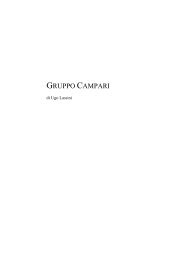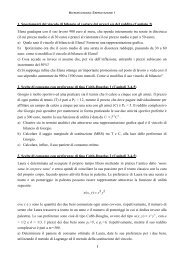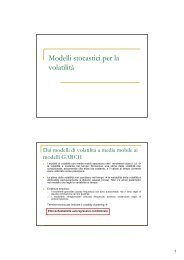Teoria della selezione del portafoglio e modelli di equilibrio del ...
Teoria della selezione del portafoglio e modelli di equilibrio del ...
Teoria della selezione del portafoglio e modelli di equilibrio del ...
You also want an ePaper? Increase the reach of your titles
YUMPU automatically turns print PDFs into web optimized ePapers that Google loves.
Visto il coefficiente angolare <strong><strong>del</strong>la</strong> semiretta in Fig. 11, è importante<br />
R1−Rf evidenziare il significato <strong>del</strong> suo reciproco, R R 1 − f , che è definito "premio al<br />
σ1<br />
rischio" o "prezzo <strong>del</strong> rischio", valutazione rilevante per le scelte finanziarie, recepita<br />
anche nei mo<strong>del</strong>li <strong>di</strong> <strong>equilibrio</strong> <strong>del</strong> mercato dei capitali come il Capital Asset Pricing<br />
Mo<strong>del</strong>31. Infatti, esplicitando la<br />
σ R f σ<br />
σ P<br />
P<br />
R Rf R Rf R<br />
=− 1<br />
1 +<br />
1 −<br />
1 −<br />
per R P si ha<br />
R1−Rf RP = Rf<br />
+ σ P<br />
σ1<br />
ovvero che<br />
⎛ ren<strong>di</strong>mento⎞<br />
prezzo premio per rischio<br />
⎜ ⎟<br />
⎜atteso<br />
<strong>di</strong> ⎟ <strong>del</strong> unità <strong>di</strong> <strong>di</strong><br />
⎜ ⎟<br />
⎝ <strong>portafoglio</strong>⎠<br />
tempo rischio <strong>portafoglio</strong><br />
=<br />
⎛ ⎞<br />
⎜ ⎟<br />
⎜ ⎟<br />
⎜ ⎟<br />
⎝ ⎠<br />
+<br />
⎛ ⎞<br />
⎜ ⎟<br />
⎜ ⎟<br />
⎜ ⎟<br />
⎝ ⎠<br />
×<br />
⎛ ⎞<br />
⎜ ⎟<br />
⎜ ⎟<br />
⎜ ⎟<br />
⎝ ⎠<br />
per qualsiasi <strong>portafoglio</strong>, efficiente o no.<br />
Si supponga ora che su un mercato coesistano:<br />
− un titolo a ren<strong>di</strong>mento certo con Rf = 8 e σf = 0;<br />
− i cinque business a ren<strong>di</strong>mento aleatorio <strong>di</strong> cui alle Tab. 2, 3, 4;<br />
e si voglia analizzare la composizione <strong>del</strong>l'alternativa non rischiosa con ognuna <strong>del</strong>le<br />
alternative a rischio.<br />
Si hanno allora cinque segmenti da (Rf = 8, σf = 0) ai punti A, B, C, D, E (in<br />
Fig.12) rispettivamente. I coefficienti angolari sono rispettivamente: 0.20, 0.29, 0.19,<br />
0.15, 0.27.<br />
( )<br />
2 2 12 /<br />
σP = xAσA = xAσA<br />
= 06 . × 141 . = 085 .<br />
Si verifica che il calcolo <strong>del</strong> rischio <strong>di</strong> <strong>portafoglio</strong> può essere fatto usando il ren<strong>di</strong>mento <strong>di</strong><br />
<strong>portafoglio</strong> nell'equazione:<br />
σARf σA<br />
σP<br />
P<br />
RA Rf RA Rf R<br />
=− +<br />
=<br />
− −<br />
.<br />
141 . × 8 141 .<br />
=− + × 12. 2 = 0. 85<br />
15 − 8 15 − 8<br />
Il coefficiente angolare <strong><strong>del</strong>la</strong> retta-frontiera efficiente in [ R P , σ P ] è:<br />
σ A<br />
=<br />
RA − Rf<br />
− =<br />
141 .<br />
020 .<br />
15 8<br />
Il suo reciproco è pari a 5, ovvero, in questo caso si hanno cinque punti <strong>di</strong> ren<strong>di</strong>mento per unità <strong>di</strong><br />
rischio.<br />
31 SHARPE W.F., 1964, op.cit.<br />
28<br />
σ 1
















